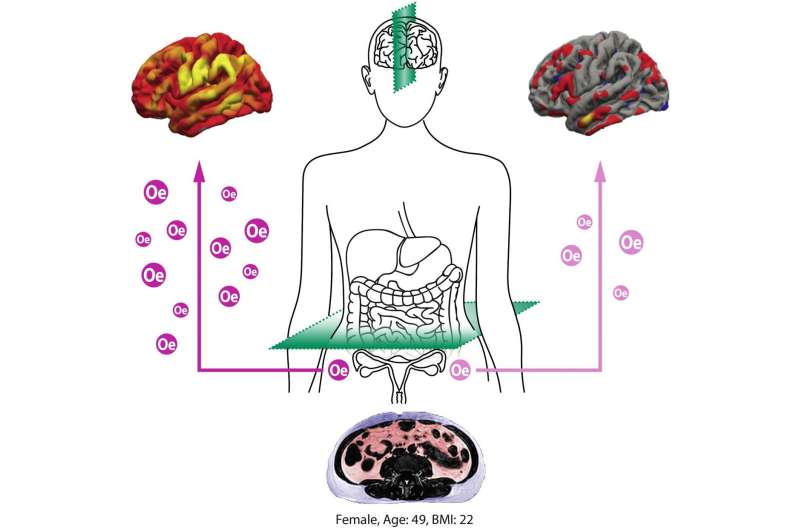Sexual hormone oestradiol protects female brain in mid-life

Recent research suggests that increased visceral fat—that is body fat surrounding a number of important internal organs such as the liver, pancreas and intestines—carries the risk of cognitive impairment in later life. "Our goal was to investigate whether excess organ fat is associated with a reduction in the structural networks and storage capacity of our brain throughout its lifetime. We also wanted to find out whether this interaction can be influenced by oestradiol," said Rachel Zsido.
Oestradiol is a hormone consisting of cholesterol and is the strongest of the three naturally produced oestrogens. It is the most important hormone found in the female body and has many amazing functions—it contributes decisively to the maintenance of the female reproductive system. Men also produce oestradiol, but in much smaller amounts. In both sexes, oestradiol is also produced by fatty tissue, the brain and the walls of blood vessels. It also has a vasodilative and antioxidant effect. Oestradiol can help maintain myelin architecture—and thus the membrane that protects our nerves.
Although visceral fat and estradiol appear to play opposite roles in the healthy ageing process of the brain, it remains unclear how and at what point they interfere with brain structure. To solve this mystery, Zsido and her colleagues examined a large data set of healthy adults aged between 20 and 80, 501 men and 473 women, from the LIFE study. "We looked at the brain structure and body fat of the volunteers on images taken from the magnetic resonance tomograph, as well as their memory and oestradiol levels in the blood. Our results suggest that increased organ fat expands the negative influence of aging on brain networks in men and women. We have also found that men prepare this organ fat earlier, while women are particularly affected in mid-life," the scientist explains.
"The decrease in oestradiol in this middle phase of life accelerates the normal aging process. It seems, however, that oestradiol protects women's brains from structural damage to the gray matter during the middle of life," adds Julia Sacher, who along with her research group is investigating the effects of hormonal changes on mood, emotional well-being and cognition. "We took a closer look at a subgroup of women between the ages of 35 and 55 and found that a low level of oestradiol is associated with weaker memory performance in the middle of life. This is also the age range in which the transition to menopause occurs, which is initially characterised by abrupt oestradiol fluctuations and finally by a stop in the reproductive phase. We therefore believe that the pre-menopausal phase provides an important window of opportunity to prevent accelerated brain aging and the development of neurodegenerative diseases such as dementia or depression in women."
Hormones important in risk recognition for dementia or depression
A second joint study led by Julia Sacher and Steffi Riedel-Heller from the Institute for Social Medicine, Occupational Medicine and Public Health (ISAP) also showed a decisive interaction between unfavourable metabolic states and another important sex hormone, testosterone. The team found that elevated testosterone levels and changes in body weight have different effects on women's susceptibility to depression before and after menopause. "Together, the results from both studies emphasize the need to further consider sex differences and sex hormones when investigating the risk of neurodegenerative diseases," summarizes Julia Sacher. This is particularly important in mid-life, as this transitional phase offers women a special opportunity for prevention.
More information: Rachel G. Zsido et al, Association of Estradiol and Visceral Fat With Structural Brain Networks and Memory Performance in Adults, JAMA Network Open (2019). DOI: 10.1001/jamanetworkopen.2019.6126

















